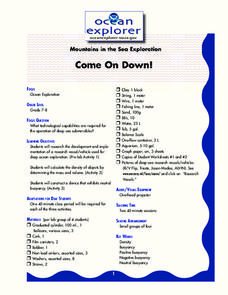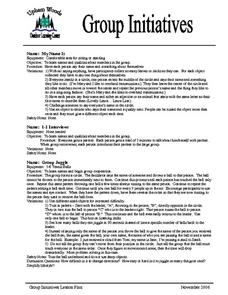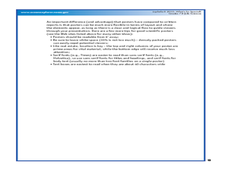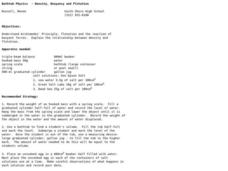Curated OER
Breaking News English: Indian Breaks Hot-Air Balloon Record
In this English worksheet, students read "Indian Breaks Hot-Air Balloon Record," and then respond to 47 fill in the blank, 7 short answer, 20 matching, and 8 true or false questions about the selection.
Curated OER
Food Web Mystery
Pupils describe typical marine food webs, and explain why food is generally scarce in the deep-ocean environment. They discuss reasons that seamounts may support a higher density of biological organisms than would appear to be possible.
Curated OER
Food Webs
Students create a bulletin board display illustrating food chains they make from a list of ocean organisms. Students also play a game showing what happens when one of the organisms is removed from the food chain and how they are all...
Curated OER
Earth Day/Nature Vocabulary
In this nature vocabulary worksheet, students identify nature vocabulary words by choosing the correct word for each picture. Students complete 18 problems.
Curated OER
Kindergarten children
In this animals worksheet, students choose where the animals live and the names of the animals. Students complete 2 activities.
Curated OER
Come On Down!
Students research the implementation of a research vessel used for ocean exploration. In buoyancy lesson students will construct a device that shows neutral buoyancy.
Curated OER
Living in Extreme Environments
Students examine the characteristics of the ocean floor and the importance of of extreme environments. In this investigative instructional activity students use four methods to sample populations, gather, record and analyze data from a...
Curated OER
Big Fleas Have Little Fleas!
Learners study seamounts and learn the importance of structures to species. In this ocean explorer lesson, students participate in an activity that teaches them how to modify a seamount so that they are more suitable for species.
Curated OER
Do You Have the Key?
Students practice using a dichotomous key. For this classification lesson, students read an article about scientific exploration and identification of new species. They use a dichotomous key to identify objects and create their own key.
Curated OER
Let's Get Specific
Students explore how different species thrive. In this speciation lesson students research and complete a lab activity.
Curated OER
The Intertidal Zone
Young scholars research the diverse animal and plant life that inhabit the intertidal zones along the Pacific rocky coast. As students progress through this lesson, they begin to recognize distinct behaviors, adaptations, and...
Curated OER
Group Initiatives
Students explore the names and qualities about members in the group. They each say their name and something about themselves. Students gather around in a circle. They listen to the teacher as he or she says the name of someone and throws...
Curated OER
Great Blobs of Jelly!
Students explain how zoo-plankton have an impact on the global process. In this ocean zoo-plankton activity students calculate carbon flux and plankton densities.
Curated OER
Ocean Drifters
Students define terms, and identify three ways in which plankton are adapted for life in the open ocean. In this ocean drift instructional activity students design a planktonic organism.
Curated OER
Outta Gas
Learners explore practical problems that are related to scuba diving. In this oxygen lesson students complete a lab activity.
Curated OER
What's So Special?
Students study the biology and morphology of Lophelia corals. In this investigative lesson students explain how the coral contributes to communities, and create a poster.
Curated OER
Picture This!
Students compare and contrast different types of light on the electromagnetic spectrum. In this investigative lesson students create a photographic image that demonstrates the infrared, ultraviolet and polarization phenomena.
Curated OER
Phytoplankton
In this phytoplankton worksheet, students read and study online information on plankton blooms to answer 8 short answer questions about the topic.
Curated OER
ESL: Sea Animals Activity
In this ESL sea animals instructional activity, students watch a video about sea animals, then identify names of animals shown in pictures.
Curated OER
Cradles of Civilization Information Sheet
In this early civilizations activity, students read 4 paragraphs about great river civilizations and then label them Nile, Tigris and Euphrates, Indus, and the Huang He River Civilizations. Student also complete a writing prompt on the...
Curated OER
Bathtub Physics - Density, Buoyancy and Flotation
Students study Archimedes' Principle, flotation and the reaction of buoyant forces and explain the relationship between density and flotation.
Curated OER
Talking About Clouds
In this weather learning exercise, students read a selection about the water cycle and cloud identification. Then the students fill in the missing words in 5 sentences and write the name of 5 cloud types while describing the clouds.
Curated OER
Instant Spelling Activity: Homophones
Second graders explore the concept of homophones. In this spelling skills lesson, 2nd graders discover the definition of homophones and practice identifying homophones. Extension activities suggested are included with this lesson.
Curated OER
Life is Weird
Students study the organisms that are found in cold seeps and see how they interact with each-other. In this biological organism lesson students describe the major features of cold seeps and the process of chemosynthesis.
Other popular searches
- Below Sea Level
- Above Below Sea Level
- Sea Level Changes
- Sea Level Rise
- Sea Level Rising
- Sea Level Rise Calculation
- Sea Level Journal
- Modelling Sea Level Changes
- Modeling Sea Level Changes
- Rising Sea Levels
- Model Ling Sea Level Changes

























